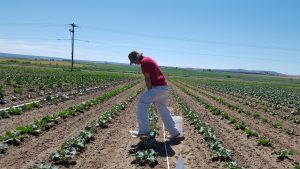Soil testing can guide farmers and gardeners in making soil amendment and soil management decisions. Taking soil samples annually will allow for tracking management practices and influencing future soil amendment decisions.
Soil test results can indicate:
- nutrient deficiencies or excesses,
- nutrient-holding capacity,
- organic matter content, and
- soil alkalinity or acidity.
The value and reliability of this information depends on how a sample is taken and what area of the farm the sample represents. Do not try to represent too large an area with one sample, especially if crops with different nutrient requirements will be planted within the same area.
If soil testing is done carefully and consistently over several years, soil test data can be used to determine the timing and amounts of fertilizer, compost, manure, lime, or other amendments aimed at improving crop response. Soil testing can also be used to evaluate soil improvement strategies, such as cover cropping. Finally, a soil test can be used to evaluate fertilizer efficiency.
Soil testing: A guide for farms with diverse vegetable crops, by Douglas Collins. Washington State University Extension. 2012. This fact sheet covers soil testing strategies for diverse vegetable crops with a specific focus on the management zone approach.
Analytical Laboratories and Consultants Serving Agriculture in the Pacific Northwest, by Washington State Pest Management Resource Service. Washington State University Extension. A searchable database that contains information on analytical laboratories, consultant and laboratory services available to perform testing for the general public, especially agriculture, in the Pacific Northwest.
Soil test interpretation guide, by D.A. Horneck, D.M. Sullivan, and J.M. Hart. Oregon State University Extension. 2011. This fact sheet describes what information is provided by a soil test and how to formulate fertilizer and amendment recommendations based on soil fertility test results.
How to take a soil sample
The variability in soil properties across the farm creates a challenge for farmers who want to describe their farm’s soil properties. Using a management zone approach to take soil samples helps ensure reliable data are collected. For farms with many different management zones, a few reference areas can be sampled from each field or soil type.
A soil sample from a reference area should be composed of many subsamples taken within the area.
- Fifteen is the minimum number of subsamples that should be taken
- Use clean, non-galvanized tools and containers for taking samples. Subsamples should be collected together in a clean bucket.
- The combined subsamples should provide enough soil for the analyses needed, usually 2 to 3 cups.
- Ask the soil lab how they prefer to receive the sample (e.g., fresh or dried) and how much soil they require. Some labs encourage growers to keep the sample refrigerated and then send it overnight to the lab. Another alternative is to air dry the samples on the day of sampling by spreading soil in a thin layer in trays or on paper or plastic.
- Make sure to send as much soil as the lab requires, and complete sample submission forms carefully and thoroughly.
Soil testing: A guide for farms with diverse vegetable crops, by Doug Collins. Washington State University Extension. 2012. This publication describes how to take into account landscape position, soil type and management history when deciding where to take soil samples.
Video: How to take a soil sample, by Craig Cogger. In this video, Dr. Craig Cogger describes how to collect a good sample for a soil test.
Monitoring Soil Nutrients in Dryland Systems Using Management Units, by Mary K. Corp, Donald A. Horneck, Donald J. Wysocki, Larry K. Lutcher. Oregon State University Extension, EM 8920. Publication discusses strategies for soil sampling in dryland farming systems.
Evaluating Soil Nutrients and pH by Depth in Situations of Limited or No Tillage in Western Oregon, by Nicole Anderson, John Hart, Donald Horneck, Dan Sullivan, and Neil Christensen. Oregon State University Extension, EM 98014. 2010. Many nutrients and lime are not mobile in the soil. When applied to the soil surface without tillage, these materials remain in the top 2 inches, especially in production systems that lack tillage. If a soil sample is taken at a standard 8-inch depth, the top 1 to 2 inches, which have higher nutrient concentrations, will be mixed with the lower 6 to 7 inches, which have lower nutrient concentrations. Surface-applied nutrients that are not mixed will likely not be measured. In addition, continued application of ammonium-N and subsequent nitrification acidifies the surface soil. Therefore, soil collected from several depths should be used to evaluate surface and below-surface conditions

